



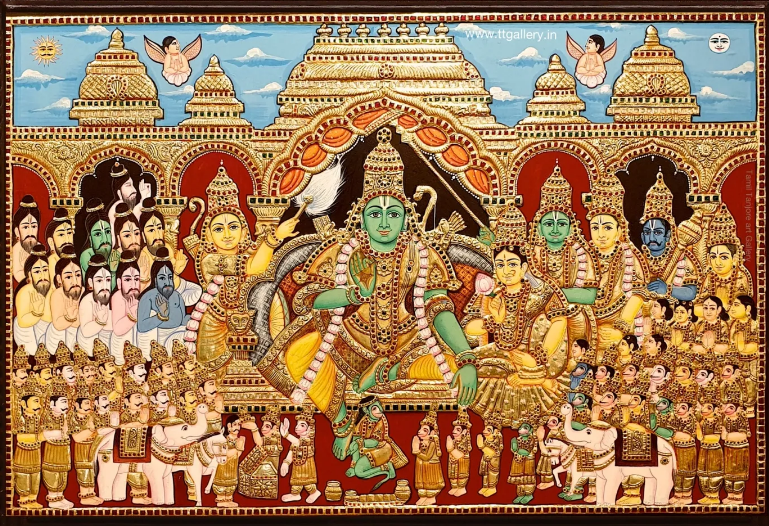
Disclaimer: Copyright infringement not intended.
Introduction
South India is best known for its brightly-colored wall paintings and richly decorated painted sculptures. Paintings in South India are famous for their intricate curves and bright colors. There are many schools for painting in South India like the Mysore, Tanjore, Nayaka, Chola and so on. Pallava period paintings are known to us from small fragments recorded in the little shrines to set into the area wall of the Kailashnath temple at Kanchipuram. Mural and album paintings from the last 2 or 3 centuries stay alive in some extent from the South Indian paintings.
History of South Indian Paintings
The art form dates back to the early 9th century which was an era dominated by the Chola rulers, who encouraged art and literature. Tanjore painting is an imperative form of classical South Indian painting was the subject to the town of Tanjore in Tamil Nadu. The Tanjore Paintings dates back to the early 9th century which was an era dominated by the Chola rulers, who promoted art and literature. The tradition of South Indian painting has been carried on in the Indian subcontinent since ancient times. With time, South Indian paintings developed to turn into a kind of merge of the different traditions which were influencing them. There are different types of South Indian Paintings which are existing today.
Features of South Indian Paintings
The ideas consist of the story of Radha-Krishna, scenes from Ramayana and Mahabharata temple activities and others. A significant feature of chitrakars is they utilize vegetable and sandstone colours.
Types of South Indian Paintings
The tradition of South Indian painting has been carried on in the Indian subcontinent since the ancient times. With the time, South Indian paintings developed to turn into a kind of merge of the different traditions which were influencing them. There are different types of South Indian Paintings which are existing and some of them are as follows:
Thanjavur Painting:
A classical artform from southern India, Thanjavur painting – also known as Tanjore painting – is a celebration of the region’s rich artistic tradition, named after the town of Thanjavur in Tamil Nadu, India. Tanjore paintings are known for their extravagant depictions of deities using vibrant colours and gaudy embellishments, especially gold foil. Though the artform has undergone various changes over the years, it continues to be popular with lovers of art even today, and inspires many artists with its truly Indian style.
It has been recognized as a Geographical indication by the Government of India in 2007–08.
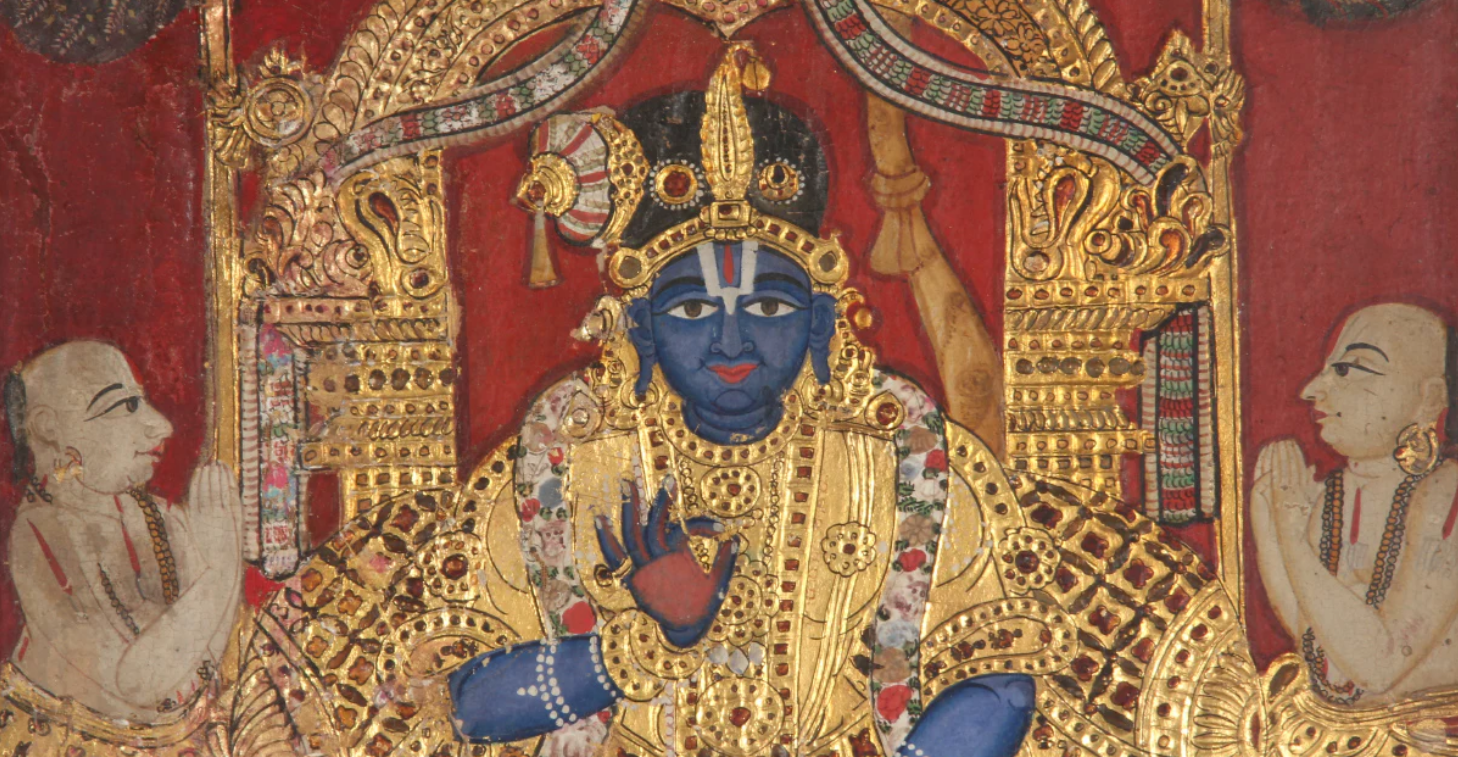
Ancient Roots and Patronage
Tanjore painting drew inspiration from Indian art of the 16th century, when the Vijayanagara Rayas administered their vast kingdom in southern India through the Nayaka Governors. The Nayakas were great patrons of art and literature.
In 1676, Maratha rule was established in the region, and Maratha rulers encouraged the flourish of art and artists. It was during this time, that Tanjore painting truly flourished and developed into the form and style in which we recognise it today.
Maratha palaces and buildings were adorned with large paintings of deities as well as Maratha rulers, courtiers and nobility. Almost all the deities were depicted with rounded faces, almond-shaped eyes and streamlined bodies. Flat colours were used to paint the figures, which were often compactly placed within arches, drapes and ornate borders. The dense composition was a distinct feature of Tanjore paintings, and faces were usually shaded to add a feeling of depth.
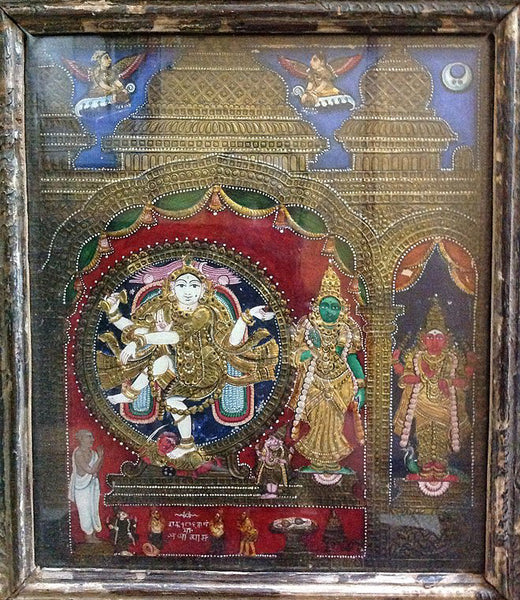
A Tanjore painting depicting Nataraja and Sivakami, circa 19th century.
The Company Style
With the decline of the Maratha rule, the Britishers who had come into Tanjore in the wake of the Mysore Wars of 1767-99 patronised the Tanjore artists. In 1773, a British garrison was installed in Tanjore and it became a base for British troops. Indian artists in and around Tanjore, prepared sets of paintings for Company personnel throughout the next century.
These sets were called albums or album paintings. They were collections of “native” or “Indian” subjects, painted in a manner that appealed to English sensibilities and tastes. The usual subjects of deities and episodes from Hindu mythology were joined in by others which piqued the interest of the English, like fairs, ceremonies, festivals, caste occupations and Indian flora and fauna. They were completed with little or no gold foil and avoided any glass or gem inlay. The paintings also carried short descriptions about the subject matter in English, and occasionally in Tamil or Telugu. Though these paintings were grouped under the Company style of painting, they were typically Tanjore in style and characterisation, and were executed by the same group of traditional artists.
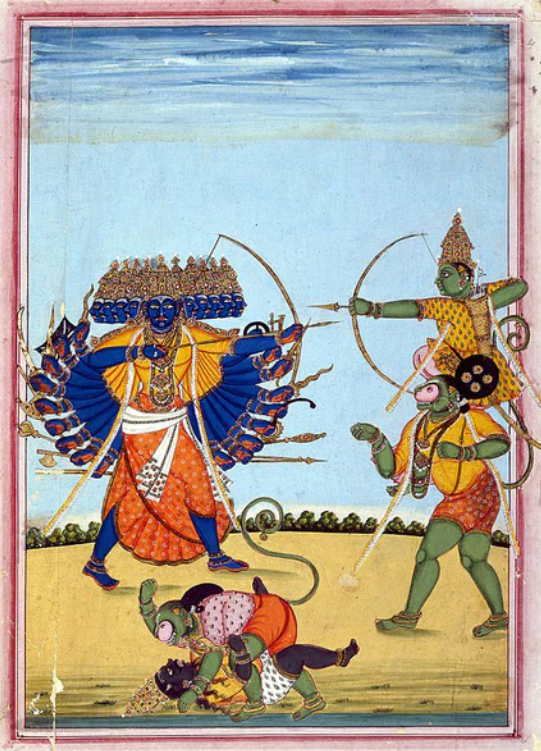
An album painting depicting Rama and Hanuman fighting Ravana
Characteristics
It is distinguished by its famous gold coating.
Thanjavur paintings are characterised by rich and vivid colors, simple iconic composition, glittering gold foils overlaid on delicate but extensive gesso work and inlay of glass beads and pieces or very rarely precious and semi-precious gems.
In Thanjavur paintings one can see the influence of Deccani, Vijayanagar, Maratha and even European or Company styles of painting. Essentially serving as devotional icons, the subjects of most paintings are Hindu gods, goddesses, and saints. Episodes from Hindu Puranas, Sthala-puranas and other religious texts were visualised, sketched or traced and painted with the main figure or figures placed in the central section of the picture (mostly within an architecturally delineated space such as a mantapa or prabhavali) surrounded by several subsidiary figures, themes and subjects. There are also many instances when Jain, Sikh, Muslim, other religious and even secular subjects were depicted in Tanjore paintings.
Style and Technique
Thanjavur paintings were made in various sizes depending upon the function, the subject and the choice of the patron. Large paintings of deities and the Maratha rulers, their courtiers and nobility, were painted and installed to serve as architectural accents in the Maratha palaces and buildings.
Paintings in addition to being done on canvas, were also done on walls, wooden panel, glass, paper, mica and exotic media such as ivory. Small Ivory portraits were typically worn as cameo pendants called rajaharam and were quite popular.
A Thanjavur Painting was generally made on a canvas pasted over a plank of wood (Jackfruit or teak) with Arabic gum. The canvas was then evenly coated with a paste of French chalk (gopi) or powdered limestone and a binding medium and dried. The artist then drew or traced using a stencil, a detailed outline of the main and subsidiary subjects on the canvas. A paste, made of limestone powder and a binding medium called sukkan or makku, was used for creating the Gesso work. Gold leaves and gems of varied hues were inlaid in selected areas like pillars, arches, thrones, dresses, etc. Finally, colours were applied on the sketch.
In the past, artists used natural colours like vegetable and mineral dyes, whereas the present day artists use chemical paints. For outlines dark brown or red was usually used. Red was favoured for the background, though blue and green were also used.
Lord Vishnu, was coloured blue, and Lord Nataraja chalk white, and his consort Goddess Sivakami was green. The sky, of course, was blue, but black was also employed on occasions. The portrayal of figures in the paintings was also typical with almost all the figures having rounded faces with almond-shaped eyes and smooth, streamlined bodies. The composition is static and two-dimensional with the figures placed within arches, curtains and decorative borders. The main subject is much larger than the other subjects and occupies the centre of the painting. Seraphs or angels resembling those in European paintings and Islamic miniatures were also shown flanking the main figure. The figures were painted with bright flat colours except for the face where shading was shown. The shading in Thanjavur art was more to create a feeling of depth than to conform to the European conventions of lighting and perspective.
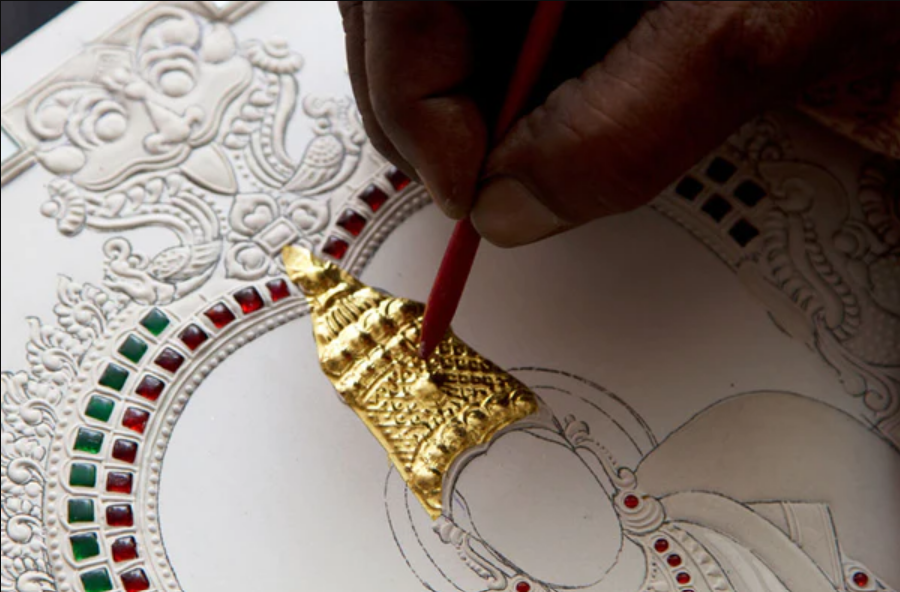
In the process of creating a Tanjore painting
Thanjavur glass paintings following the techniques of Chinese reverse glass paintings were popularised during Serfoji II's reign as a cheaper and faster craft. The paintings were done on the reverse surface of a glass sheet with strips of metal beaten into transparent gaps to simulate the effect of jewellery and precious stones. Most of the paintings were of Hindu deities & saints. Other courtly and secular portraits were also created.
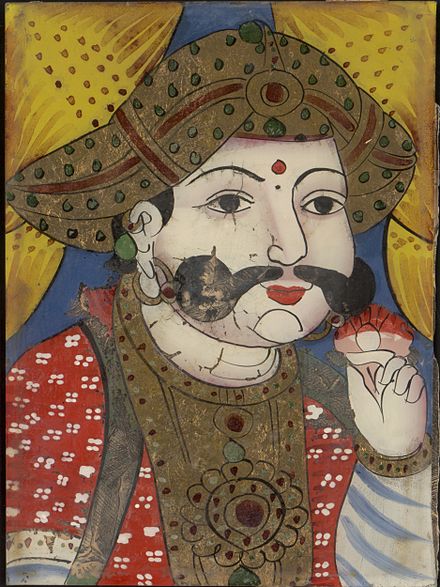
Tanjore Glass painting of Raja Sarabhoji, c. 1860
A Migrant Artist Community
In the olden days, Tanjore paintings were executed by the Raju community of Tanjore and Tiruchy and the Naidu community of Madurai. These artists, who were originally Telugu-speaking and hailing from Andhra Pradesh, moved to Tamil Nadu after the fall of the Vijayanagara Empire. Patronage was of utmost importance to these artists, and even the size of the paintings varied depending upon the subject and the patron’s choices.
The technique of Tanjore painting demanded a great deal of perseverance and perfection from artists. Furthermore, the creation of the artwork, considered a sacred task, was to be performed with some degree of ritual purity and humility by the master craftsmen. Remaining true to the Indian artistic tradition, most artists chose to remain anonymous and never signed their paintings.
Diverse Stylistic Influences
Tanjore painting not only drew heavily from the diverse cultural groups that patronised the artform – it was also influenced by other prominent painting styles which were under the Vijayanagara school, like the Kalamkari and Tirupati styles of painting. Tirupati paintings, produced in the famous temple town of Tirupati using different media and techniques, portrayed deities, and many were gilded and gem-set in a manner similar to Tanjore paintings.
A bulk of reverse glass paintings – another genre of traditional Indian art – which were from southern India, were heavily influenced by Tanjore painting and depicted religious figures in vibrant colours, with metallic foils and details adding to the richness of the artworks.
The popular artform of Mysore painting shares many characteristics with Tanjore painting, often leading to confusion between the two. They were both executed by artists from the Raju and Naidu communities, and have roots in the Vijayanagara period. Though the styles are remarkably similar, there are notable differences like the use of paper as the base for Mysore paintings and its limited use of gold foil, glass beads and precious and semi-precious stones. The themes in Mysore paintings are reflective of the contemporary style which was prevalent in the Mysore Palace, and also features more elaborate landscapes, in contrast to the dense composition of Tanjore paintings.
Thanjavur paintings are panel paintings done on wooden planks, and hence referred to as palagai padam (palagai = "wooden plank"; padam = "picture") in local parlance. In modern times, these paintings have become souvenirs for festive occasions in South India.
Mysore painting is an important form of classical South Indian painting that originated in the town of Mysore in Karnataka. These paintings are known for their elegance, muted colours and attention to detail. The themes for most of these paintings are Hindu Gods and Goddesses and scenes from Hindu mythology. In modern times, these paintings have become a much sought-after souvenir during festive occasions in South India.
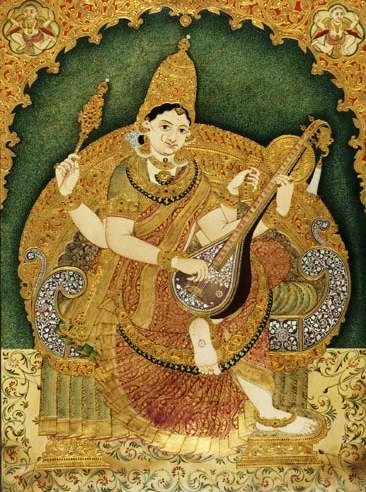
Mysore Painting depicting Goddess Saraswati
Mysore Paintings: Tracing the roots
The former state of Mysore established a unique and distinctive form of painting that came to be known as the Mysore School in the 17th and 18th centuries. This classical style of South Indian painting was initially born out of the dissolution of the Vijaynagara Empire in 1565. [With the fall of the Vijayanagar empire after the Battle of Talikota- fought between the Vijayanagar kings and the Deccan Kings in 1565. Ramaraya was defeated in this war.]. The rulers of Vijaynagara had been great patrons of the arts. When the artisans lost this patronage, they migrated to other areas such as Tanjore, Mysore and Shorapur, looking for work. Absorbing local techniques, their styles changed over time to form the different schools of paintings that are famous in South India even today.
The genesis of the Mysore School of painting can be traced back to the rule of Raja Wodeyar I (1578–1617), who provided patronage to several families of painters of the Vijayanagara School in his capital Srirangapatna. Subsequent rulers also patronised these painters, commissioning them to work on palaces and temples. Up until that point, Mysore paintings were mostly murals, and very few of those survive today. The ruler Krishnaraja Wadiyar III, who was the twenty second Maharaja of Mysore, from 1799 to 1868, put a renewed effort into encouraging the arts. Many of the traditional paintings of the Mysore School which have survived until today, belong to this reign or later. These paintings were used for domestic worship and served as a portable puja altar.
Mysore paintings often get compared to or confused with the more well-known Tanjore paintings, but the two styles are quite distinct. Mysore paintings are more delicate and feature softer colours, finer brushwork and more intricate gesso work. The subjects portrayed in Mysore paintings also tend to be more varied than Tanjore paintings, even though they both depicts gods, goddesses, and stories from Hindu mythology.
Note: Mysore Paintings are characterized by delicate lines, intricate brush strokes, graceful delineation of figures and the discreet use of bright vegetable colours and lustrous gold leaf. More than mere decorative pieces, the paintings are designed to inspire feelings of devotion and humility in the viewer. The painter’s individual skill in giving expression to various emotions is therefore of paramount importance to this style of painting.
Stages of Painting
The first stage of creating a Mysore Painting was to prepare the base, which could be paper, wood or cloth. The paper board was made of paper pulp or wastepaper, which was dried in the sun and then rubbed smooth with a polished quartz pebble. Cloth was pasted onto a wooden board and then dried and burnished. Wood surfaces were prepared by applying dry white lead, yellow ochre and gum. The colours used to create Mysore Paintings were vegetable based or extracted from minerals and flowers.
After preparation of the ground a rough sketch of the picture was drawn with crayon prepared from the straight twigs of the tamarind tree. The next step was to paint the furthest objects such as sky, hill and river and then gradually animal and human figures were approached in greater detail. After colouring the figures, the artists would turn to elaboration of the faces, dress and ornaments.
The long-lasting quality of the natural colours ensure that original Mysore paintings still retain their freshness and lustre even after decades have gone by. Brushes were made with squirrel hair for delicate work. For drawing fine lines, blades of a special variety of grass had to be used. Finally, the figures would be decorated using gesso work. Gesso is a paste mixture of white lead powder, gambose and glue. The gesso work in Mysore paintings is low in relief compared to the thick gold relief work of the Tanjore School. Gesso was used in Mysore painting for depicting intricate designs of clothes, jewellery and architectural details on pillars and arches that usually framed the deities.
Documenting Indian Mythology
Like other classical and traditional Indian art, Mysore Paintings usually depicts Hindu gods, goddesses and stories from Indian mythology. Some popular subjects like Lord Rama's coronation, or Bala Krishna with his mother Yashoda are often seen in Mysore paintings, along with other more rare depictions of Vaishnavite saints, mythological figures such as Garuda, or Vishnu in his different avatars.
.jpg)
Mysore Painting depicting Krishna with his eight principal wives.
Intricacy and Detailing
Using fine brushes made from squirrel hair or blades of grass, artists of the Mysore School created spectacular detailing in small format artworks. The realism in every detail they painted - from facial expressions to the elaborate jewellery, patterns on the clothes to the detailing of the background - is truly breathtaking.
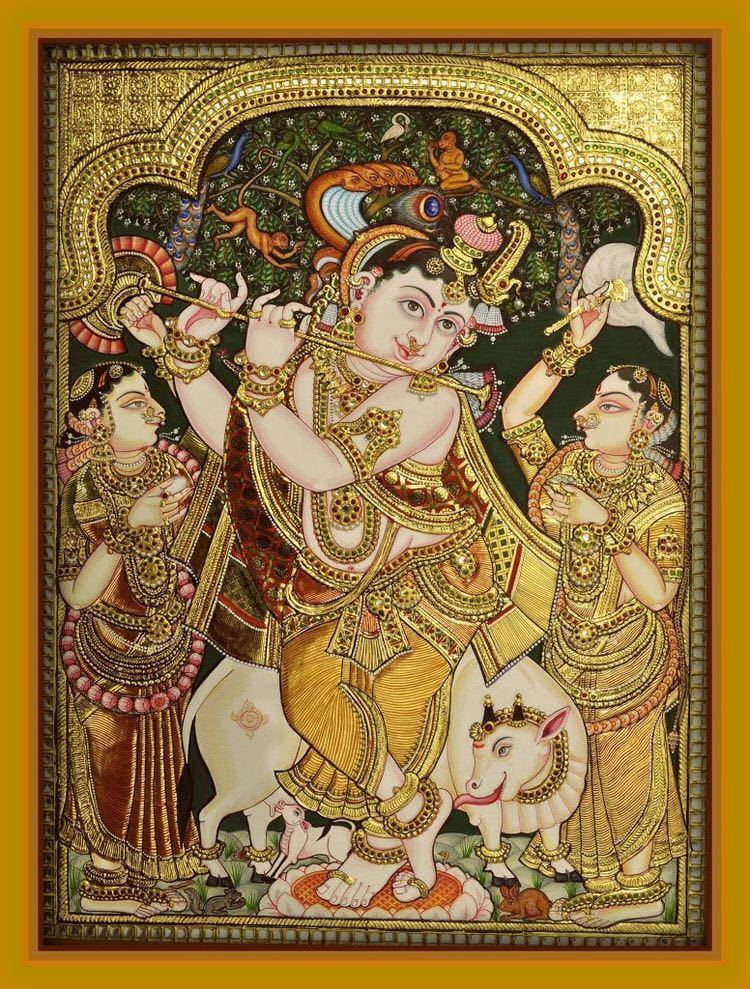
Karnataka paintings follow a long line of development. The earliest paintings in Karnataka can be traced back to the megalithic people who occupied Karnataka in the 1st millennium B.C. There handiworks are mostly in the form of primitive paintings which were made on the walls of caves etc. They mostly depicted the animal life of the region. From the megalithic times, the advancement of painting was seen on pottery and other articles, murals on caves, on temples, on the walls of mansions and palaces and on paper. Etchings from the time of Emperor Ashoka can be seen in rock boulders in the region, which gives inkling into the life of the people at the time.
The earliest murals found in Karnataka are seen at Badami. These were made in the 6th century under the Chalukya kings who held sway over the region. Early Buddhist influences can be seen rather strongly in these paintings. The Rashtrakutas who followed them continued the patronage towards painting and the other arts. The Ajanta caves, the earliest examples of murals in India, became the centre for religious and cultural interest. However, there seems to be a sudden lull in the painting scenario. The continuity that is seen in the field of art and architecture is lost in the case of Karnataka paintings. After the solitary instance of the Badami murals, the next big works are seen in the Vijayanagara period (1336-1665 AD), and that too in the 15th-16th centuries. Thus, after a gap of almost 3 to 4 centuries, a few murals are to be seen. However, based on the extensive paintings found throughout the region, belonging to different points in time, the various Karnataka paintings can be more comprehensively studied by dwelling on their style, type and influences.
Types of Karnataka Paintings
Broadly speaking, the Karnataka paintings can be classified into three main types. These are murals, illustrated manuscripts and miniatures.
Murals are paintings which have been done on caves and on the ceilings and walls of temples, palaces and mansions. The most well known murals in Karnataka paintings are the Badami murals which were made during the rule of the Chalukya dynasty. The most outstanding example of cave murals can be seen at Ellora caves, which display paintings from all three religions. Temple murals in Karnataka can be seen at the Lepakshi temple built during Vijayanagara times. They are found on the high ceiling of the huge gateway, the vimana, of the Virupakshi temple. As regards the paintings on the walls and ceilings of palaces and mansions, Athani, Nippana and Nargund contain some excellent examples of the same.
Illustrated Manuscripts include paintings done on handy materials, like palm leaf, wood panels, cloth, paper etc. Since all these are quite old and can be easily transferred, they are also easily destroyed. In Karnataka, the earliest manuscripts were written on palm leaf. Since they deteriorated easily, palm leaf manuscripts older than 3 centuries are rather rare. The use of hand-made paper for books began with the Muslim advent in the Deccan. This style was mostly favoured by the rulers of Bijapur and Ahmednagar. However, this activity remained confined to the royal courts and the use of palm leaf continued among the common people. Though manuscripts do not usually contain illustrations, the Dhavala manuscripts at Mudabidri have remarkable illustrations on them. The manuscripts make up three texts, and two out of three contain beautiful coloured illustrations.
Most of the miniatures in Karnataka paintings are of the Muslim rulers of Bijapur. A distinct style of painting developed when Karnataka paintings came into contact with the Mughal influence. Thus most of the miniatures were produced during the rule of the Adil Shahi dynasty of Bijapur, up towards the northern part of Karnataka.
Style of Karnataka Paintings
Karnataka paintings show a great variety in style. However, this does not indicate that one particular kind of style was found at one particular point in time, as the time frames for the different painting style can be found to overlap. Based on a general view, three main painting styles emerge in the Karnataka paintings. These can be better understood with reference to the most outstanding piece of work made in that particular style.
Deccani School of Painting
Deccani School of Painting emerged in the Adil Shahi period. It developed during the Mughal era, and has adopted quite a bit from the Mughal style though it is not similar to it. This genre of paintings mostly deals with miniatures, portraits and even to some extent illustrations produced during the Adil Shahi period.
_.jpg)
Sultan Ibrahim Adil Shah II, miniature, Bijapur, c. 1590.
The artists of the Deccani paintings displayed warm colours and a fine sense of line and composition. This is more sophisticated than the normal folk art, and remarkable self-restraint can be seen in the paintings.
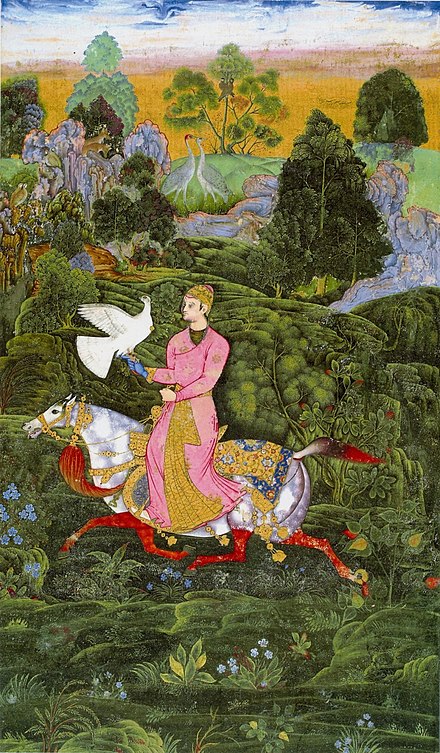
They drew inspiration from Amir Khusru's book of poems which has excellent illustrations in the Persian style. The common topics that these portraits dealt with were to do with religion which included the paintings of Gods and goddesses like Saraswati and Lakshmi, paintings of ragas and raginis due to the patronage given to the arts, and a number of paintings were portraits of famous court personalities of the time.
Lepakshi paintings
Lepakshi paintings comprise one of the most significant murals in Karnataka paintings. This temple was constructed in the 16th century during the Vijayanagara period. The murals are seen on the high ceiling of the huge gateway of the Veerabhadra temple.
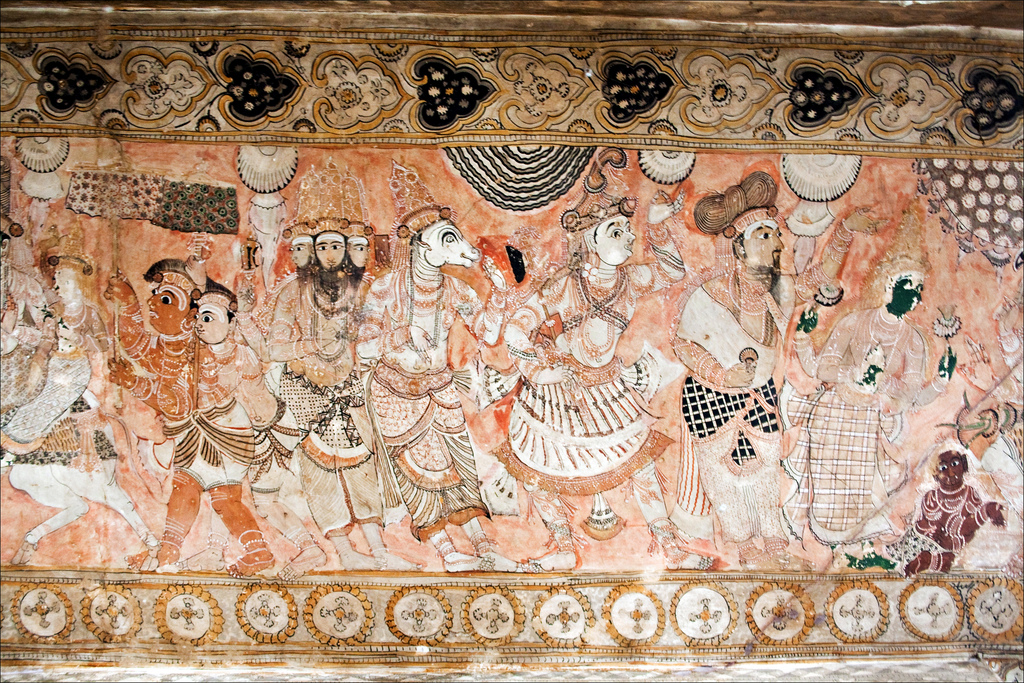
Most of the murals here deal with figures and themes from mythology. Most of the panels here depict the Hindu Gods- Lord Shiva, Lord Vishnu etc. Mythological characters like Arjuna can also be seen here. Some of the murals have been dedicated to unknown figures. The preferred style seems to have been painting in profile which is abundantly seen here. The profile figures are shown tilting backwards, from the feet upwards till the waist, and then again forward from the waist to the neck. The head stands erect. Great detailing has been put into the costumes and ornaments of the various figures. The panels are bordered with decorative margins on four sides, which go very well with the central panel. The background has been made in a light shade which better captures the figures in front. The line work is not continuous, and sometimes some facial profiles may not have a line at all. In terms of both the brush work and the lines, the parts do not attain unity with the total figure.
Dhavala Manuscripts
This style of painting is seen in the Dhavala manuscripts, which are illustrated manuscripts dating back to over 750 years. The manuscripts are ancient Jain texts that have been divided into three books, and two out of these contain coloured illustrations. The texts occupy the right and left margins of the palm leaves, and the middle portion contains the illustrations.
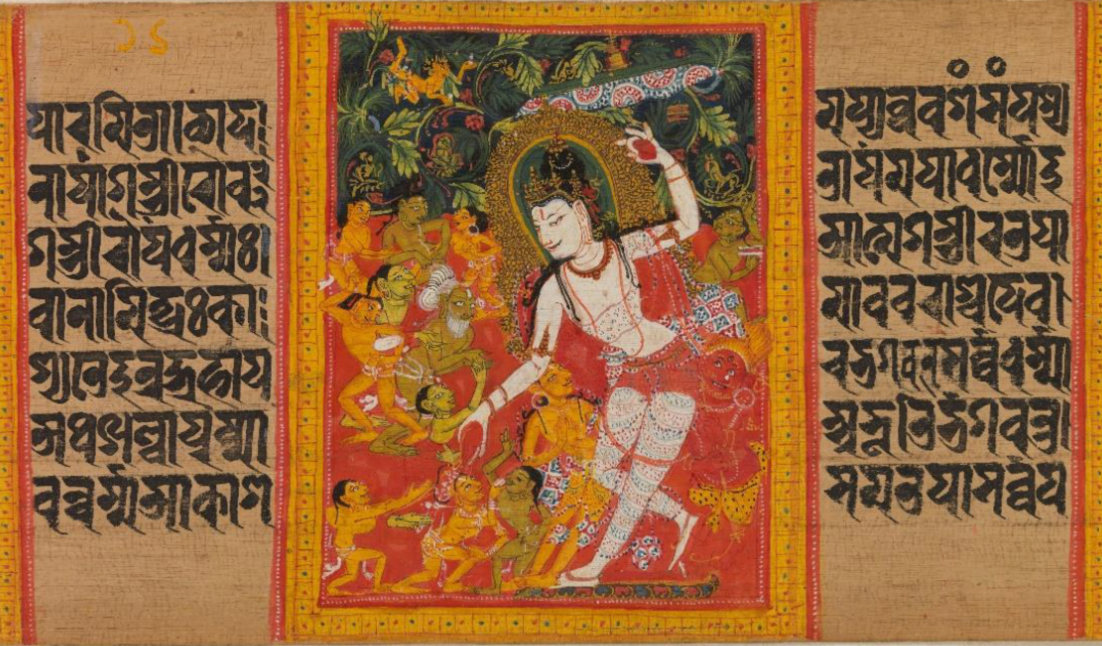
The subject of the paintings is Jain tirthankaras, Munis, Yakshas and Yakshinis. On the right and left edges decorative borders have been painted. The fine line work delineates the various figures and the spaces within and without are worked in flat colours. Tempera colours have rarely been used and light shades are rarely used. The main features characteristics of the illustrations are fine craftsmanship and charming flat colours.
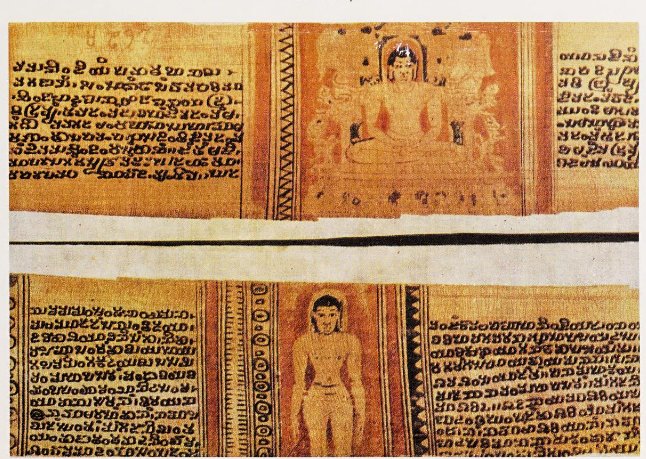
Religious Influence on Karnataka Paintings
It must be noted here that religion is a recurring theme in all the Karnataka paintings, irrespective of the time or style of its creation. The image of Lord Krishna as an unpredictable, adventurous child, and also his love life, has given enough material for depicting the lord in many moods. Depiction of Hindu Gods and Goddesses- Saraswati, Lakshmi, Lord Vishnu, Lord Shiva- is seen as a persistent theme in all of Karnataka paintings, even when the influence of Muslim rule was felt in the Deccani paintings. In the Lepakshi murals, the religious theme abounds. The murals consist of many mythological scenes, and there are numerous panels here which depict Lord Shiva and Parvati as Uma. Also seen here is Arjuna's archery feat with Draupadi by his side even in the later paintings such as the mansions at Nippani, Athani and the Nargund palace, the religious themes continue.
Karnataka paintings can thus be seen covering a broad spectrum in terms of era and style. Though there was the danger of losing this art form after the sudden lull following the Badami murals, the Lepakshi paintings once again ensured that Karnataka paintings shone forth in their full splendour. Despite the time of their existence and the influences exerted on them, Karnataka paintings have managed to keep their essence intact, and they are the remarkable legacies of majestic dynasties long gone from history.
The Hoysala dynasty ruled in ancient Karnataka area from the 11th to the13th centuries A.D. They constructed many beautiful temples in South India, which reflected a unique style of architecture and sculpture of them. They are still remembered for that unique feature of their art and architecture.
During, the rule of the Hoysala dynasty the art of painting also reached great heights. Murals of their time cannot be seen in the temples but samples of Hoysala paintings are available in the painted palm leaf manuscripts, which they have left behind. These can be seen now at Moodhidri, a Jaina pontifical seat in Karnataka. These Hoysala paintings can be seen on very large sized palm leaves, which are now well preserved in the Moodhidri library. They are actually illustrated manuscripts and therefore contain not only paintings but also the writing of the Hoysala period. A comparative study of the writings found on these palm leaves with the inscriptions of the Hoysalas discloses that the former belong to the time of the great Hoysala ruler Vishnuvardhana and his wife, Shantala Devi who was a follower of Jainism.
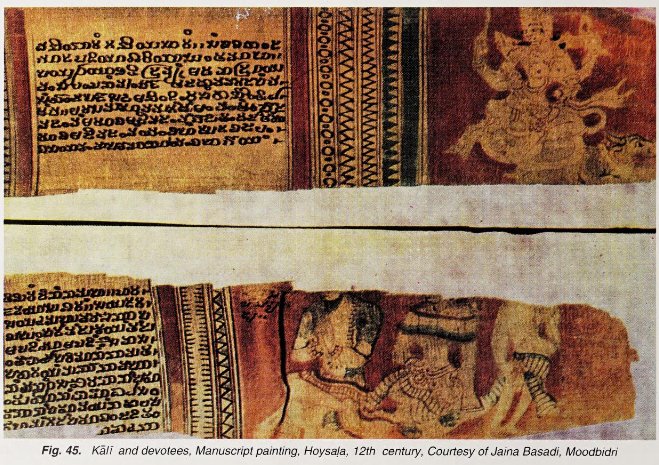
One of these manuscripts painting of Hoysala dynasty is the commentary of Virasena known as Dharala. It can be traced back to the 1113 A.D. and the Yakshi Kali is seen here with her vehicle the bull and standing close by are a few royal devotees, probably the ruler, his queen and the prince, all depicted with great beauty and delicacy. The other remarkable figures in these paintings include the figures of Mahavira, in both the standing and seated postures and also one of the Parshvanatha with snake hoods above his head and sitting on a lion throne. These manuscript paintings found in this library include the 'Yakshini Ambika', who is well represented in all of Jaina art. In one of these manuscripts here, she is shown under a mango tree with her two children and the lion. One of her children is shown riding on the lion while the other is standing close to his mother.
The quality of these Hoysala paintings is really outstanding and the writings found on these manuscripts are also noteworthy. The letters are painted in a flowery style and tell volumes of the skill and patience of these dedicated artists. The manuscripts are embroidered with beautiful borders, which too have been executed with deftness and sublime beauty.
© 2025 iasgyan. All right reserved